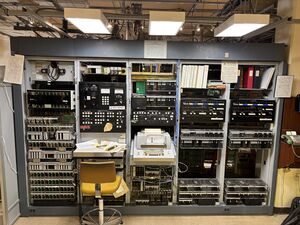Number Three Electronic Switching System

The Number Three Electronic Switching System (3ESS) is a smaller scale electronic switching system that was manufactured by Western Electric starting in 1976. It was designed to serve only a few thousand lines compared to the larger capacities of the 1ESS and 2ESS. Due to new requirements for switching systems such as the ability to use different long distance providers for each subscriber as part of the 1984 Bell Systems divestiture, as well as rapidly progressing integrated circuit technology which made replacements more cost effective, most 3ESS switches had a relatively short service life (10-15 years) compared to other switches (~50 years).
Features
The 3ESS provided several features that were not available on older switching systems, such as the following:
- call forwarding
- three-way calling
- remote monitoring and maintenance
Technology
The system makes use of a control complex consisting of two custom-designed minicomputers running in an active/standby configuration. It uses a stored program, known as a generic, to control the basic functions of the switching network. The generic also includes maintenance and administration routines, such as self-tests, fault recovery, man-machine interface handling, and job execution control. The generic is loaded at boot from a tape drive, along with translations that contain the data specific to this particular machine. This data includes variables such as line and trunk assignments, etc.
The switching network is a space-division, 5-stage, folded design, which utilizes remreeds (remnant-reeds) as crosspoints. Essentially, this means that even though the machine is computer controlled, it still switches physical circuits like the older electromechanical switches. A folded network is one where all trunks, lines, and service circuits appear on only one side of the network, in stage 1. A call enters the network at stage 1, and proceeds through the remaining stages before folding back and reaching its destination again at stage 1. This is in contrast to a step-by-step or panel switch, which does not use a folded network. Calls always enter on one end, and leave on the other end.
The 3ESS did not have enough memory to track each subscriber’s long distance provider, hence the need to migrate from 3ESS after the Bell System breakup and subsequent requirement to allow each subscriber to use a long distance provider of their choice.
